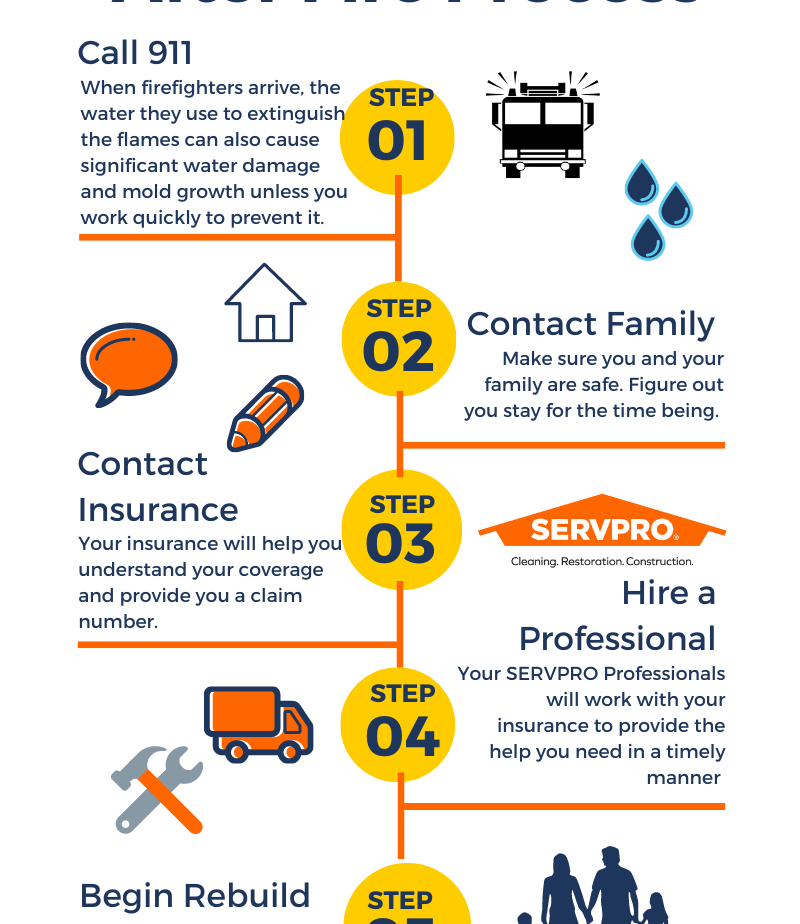Recent Fire Damage Posts
Rising from the Ashes: How SERVPRO Helps You Overcome Fire Damage
8/5/2024 (Permalink)
The force of fire be very destructive and the result can cause emotional distress, as well as financial turmoil for those who own these buildings. However, all hope is not lost; with the help of SERVPRO®, getting the help that you need will allow you to rise from those ashes to rebuild your life and property. Here is where SERVPRO steps in. SERVPRO assists those that have been struck by catastrophic fires with our full range of services. SERVPRO ranks highest when it comes to going back in time on fire damage, with state-of-the-art equipment and methodology as well as certified technicians. Understanding Fire Damage One of the first steps to fire damage restoration is determining just how extensive the destruction actually was. Many damages occur due to a fire, and some are not so obvious such as flame-related damage, the remains of smoke or soot along with water used for putting out the fire. Since each form will need unique methods of restoration, it is important to leave the process to experts such as SERVPRO. The SERVPRO Way SERVPRO hopes to take a "Like it never even happened" approach toward fire damage restoration. It is not just about simply repairing damage but rather restoration to original condition. Emergency Contact: The moment you contact SERVPRO, our representatives start off the process of restoration. We know just how much time is of essence when mitigation regarding fire damage comes into the picture, hence our service is 24/7, 365 days a year. Assessment: Our highly trained technicians start with the surface examination and testing the fire, smoke, soot-damaged areas. This provides the foundation for the planning process Board-Up and Roof Tarp Service: Boarding up missing windows, walls or doors and if needed roof tarping is done to prevent further damage by SERVPERO. Water Removal and Drying: In cases of water loss as a result of firefighting, SERVPRO will start the water removal process immediately. Dehumidifiers and air movers are set up to remove the remaining water as fast as possible and to complete drying. Smoke and Soot Removal: SERVPRO removes smoke and soot from ceilings, walls, and other surfaces with state-of-the-art equipment and techniques. Cleaning and Sanitizing: Your belongings are cleaned with professional methods of cleaning, sanitizing, and deodorization. Deodorization, in addition to eliminating odors, is also conducted with the aid of industrial air scrubbers and fogging equipment. They reverse the various effects of smoke smells. Restoration: The last process is actual restoration of your house or business to its pre-fire condition. Restoration can entail small repairs such as drywall replacement and painting, or large-scale repairs like rebuilding specific areas/rooms. Why SERVPRO? What really sets us apart is our commitment to attention to detail and quality. We understand the stress and worry that comes with a fire or water damage and the interruption it causes to your life and home. Our goal is to help minimize the disruption to your life and quickly make it “Like it never even happened”. In addition to that, highly trained professionals apply top-notch restoration techniques with the finest equipment available today to deliver the most satisfactory results possible.
Helpful Tips After Experiencing a Home or Property Fire
8/8/2023 (Permalink)
A home or property fire can be a very scary and traumatic experience. It can leave you feeling nervous, panicked, and overwhelmed and the feeling isn’t over yet. The aftermath of the fire can leave you just as anxious if you don’t know what to do. Fortunately, as fire damage restoration experts we understand what you might be feeling, and we’re here to help. In this blog post, we will provide you with helpful tips to navigate the aftermath of a fire, guiding you towards a swift recovery with the reliable assistance of SERVPRO.
Ensure your safety.
- Take care and depart from your abode without delay.
- Request medical assistance if needed.
To ensure the safe entry of your property, contact the local fire department.
- Assess the damage.
- After the fire has sparked, assess the damage. Obtain photographs or videos for insurance claims purposes.
Secure valuable belongings such as ID papers, jewelry, and crucial documents in a secure place.
- Contact your insurance provider.
- Make sure to inform your insurance provider about the fire immediately. Take note of all discussions and communications with your insurance provider for future reference.
Secure the property.
- Be vigilant and prevent any potential harm to your property. Board up windows, tarp or cover roof damage and secure any openings.
- Emergency services, such as temporary board ups and roof tarping, are available from SERVPRO to avoid further damage.
Request for expert fire damage restoration services.
- Call SERVPRO for a fire damage assessment and plan of action for restoration.
- SERVPRO uses state-of the art equipment and restoration techniques to efficiently clean, deodorize and restore your property.
- Reduce the impact of smoke and dust. Using SERVPRO's advanced equipment, you can remove smoke, soot, and smells from your property and restore it to its pre-fire state. We thoroughly clean affected surfaces, furnishings and HVAC systems ensuring smoke and soot are removed.
Deal with Water Damage:
- During firefighting, water can cause significant harm. Our experts use state-of-the-art equipment, such as dehumidifiers and air movers, to completely dry out the affected areas and prevent mold growth.
Conclusion:
Recovering from a home or property fire requires professional expertise and guidance. SERVPRO is here to help you during this challenging time. Our dedicated team of professionals will work with compassion, efficiency, and expertise to restore your property to its pre-fire condition. Contact SERVPRO today, and let us handle the restoration process, allowing you to focus on rebuilding your life.
What to do after a Home or Commercial Property Fire!
6/24/2022 (Permalink)
Experiencing a Home or Commercial Property fire can be a very traumatic experience and leave you feeling overwhelmed and confused. SERVPRO understands the anxiety that comes when a water or fire damage event hits your home or business. Our professionally trained staff is accustomed to handling these emergencies, and we strive to minimize the disruption for you so you can get back to normal life, soon. We’re a trusted leader in fire and water cleanup, restoration services, pathogen, and biohazard cleaning, and more. Our experience in this service allows us you help understand and answer some of the questions you may have and leave you with some insightful tips. The following is a list of tips we believe will help us through a difficult experience.
Call for Help
This may seem obvious for some but in the case of panic, your mind may be in a state of stress and confusion. Remove yourself from immediate danger and call for help. In the case of an emergency first responders are trained professionals with experience in dangerous situations Getting out of the home or property and seeking help from your first responder may be detrimental to saving others and your own life.
Take a moment to collect your thoughts
A backdraft of emotions often sweeps over the homeowners after a fire ravages a home. Fear, uncertainty, stress and doubt about the future of the property can overwhelm the homeowner long after the flames have extinguished, and the smoke has cleared. Once the first responders have arrived and you are no longer in immediate danger, take a moment. Understand that you may have just undergone a traumatic experience. Take a deep breath and take a moment to gather your thoughts. Taking a moment to collect your thoughts and clear your mind you may be able to better assist and communicate with your first responders. Help the first responders to answer questions they may have such as the number of individuals on or in the property and the cause of the fire. Help the first responders to make sure all individuals are safe. People and animals that are injured may need to be transported to a hospital or veterinarian for immediate help.
Contact your property manager or Insurance Agent
Contact your property manager to let them know what has transpired. Your property manager may have essential resources to help, such as new or temporary housing. Your property manager may also need to collect information from you to file an insurance claim. Contact your insurance company immediately. Insurance companies may take some time to process claims and the quicker that you are, the better. Many insurance companies face casualty losses such as fires and have national accounts with professional restoration companies. Such as SERVPRO, utilize highly trained and skilled technicians alongside advanced technologies to get your home back together “Like it never even happened”
Secure your property ad Call a reputable restoration company
Many restoration companies such as SERVPRO have emergency response teams that are available 24/7. Depending on the damage the company to come to your home and begin as soon as the fire department allows. When it is safe they will secure the property, and start pumping out water and drying material to reduce water damage and mold infestation. Restoration companies such as SERVPRO will help you understand the true damages of your property.
The first 48 hours after fire damage can make the difference between restoring and replacing your property and personal belongings. SERVPRO franchise professionals can help prevent fire damage from creating long-term problems. SERVPRO franchise professionals provide timely response with mitigation services ranging from fire, smoke, and soot removal to contents claims inventory and document restoration. These services help ensure your property, belongings, and memories are restored to preloss condition when possible. Here are a few tips you might be able to do until help arrives
- Limit movement in the home to prevent soot particles from spreading and additional damage from occurring.
- Place clean towels or old linens on rugs and high traffic areas and upholstery.
- Coat chrome faucets, trim, and appliances with petroleum jelly or oil.
- Place aluminum foil or wood blocks between furniture legs and wet carpet.
- Do not wash any walls or painted surfaces.
- Do not shampoo carpet or upholstery.
- Do not clean any electrical equipment.
- Do not send clothing to a dry cleaner since improper cleaning may set up smoke odor.
10 Safety Tips to Prevent a Dryer Fire
3/11/2022 (Permalink)
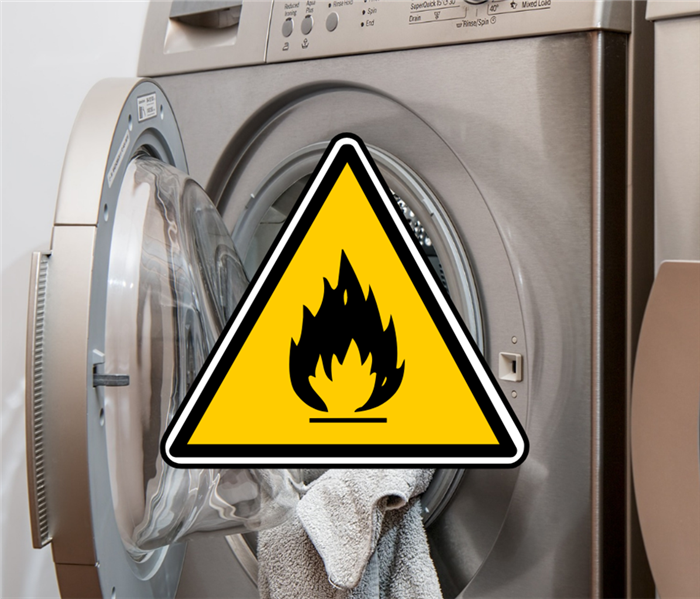 Consider running the dryer only when you are home and awake for your own safety.
Consider running the dryer only when you are home and awake for your own safety.
We usually wash and dry our clothes on a daily or weekly basis. However, it is critical to keep your clothes dryer in good working order in order to keep your home and family safe. Avoiding these specific bad habits can help you avoid a potentially disastrous house fire.
1. Installation by a Professional
Professional technicians can ensure that your dryer is installed correctly and carefully. These professionals should be knowledgeable about a wide range of units, including gas and electric dryers, as well as washer/dryer combos. Most manufacturer recommendations, such as proper vent pipe installation, are familiar to these technicians.
A technician would explain how minimizing bends in the pipe is important because it creates fewer opportunities for lint to accumulate. They can install a dryer vent fan for you if the distance between the vent and your dryer is significant. This is an automatic electric device that increases airflow through the duct whenever the dryer is turned on. Having a professional install and service your dryer unit can help ensure that any potential hazards are handled correctly.
2. Ongoing Maintenance
According to experts, the primary cause of clothes dryer fires is a failure to clean and maintain them. Check behind the dryer, where lint tends to accumulate. You should clean your dryer once a year and inspect the hose and vent for blockages twice a year.
It is a good idea to have a qualified service person clean the interior of the dryer chassis once a year. This will reduce the amount of lint that accumulates while also providing you with a professional opinion on the safety of your unit. In addition, a professional can inspect the venting and exhaust system. Employ only certified dryer exhaust technicians to ensure that this procedure is carried out correctly.
3. Keep Flammables to a Minimum in the Surrounding Area
Dryer lint is not the only flammable that should be considered and kept away from the dryer unit's heat. Anything flammable should be swept up and disposed of before it accumulates and creates a fire hazard. Cleaning up dust and lint is time-consuming, but it is far less difficult than dealing with the aftermath of a fire.
On the same note, do not store cleaning products, boxes, or clothing baskets near the dryer because they may start a fire that spreads quickly. While this is an extreme case, keeping the area clutter-free is an important step toward fire prevention.
4. Remove and clean the lint filter before and after each load of laundry.
Household dust and lint are the most common sources of ignition in dryer fires. They congregate within the dryer cavity, which is located near the heating elements. Temperatures can reach 550° here, which is hot enough to start a fire. It is never a good idea to forget to clean out your lint filter.
Cleaning the lint screen before and after each drying cycle is a good habit to get into during your laundry routine. This is an obvious first line of defense in the prevention of dryer fires. Wiping down the interior of the dryer will also remove excess lint buildup that the screen does not catch. This is a less obvious step that many people overlook, but it is nonetheless critical.
It is also critical that you never use a dryer without a lint filter, as this removes the dryer's built-in defense against hazardous lint buildup. This may seem obvious, but you'd be surprised how frequently it occurs.
5. Only use metal venting material that is rigid or flexible
Most clothes dryer manufacturers recommend using flexible or rigid metal venting material to maintain proper drying time and airflow. Lint can accumulate in accordion-style ductwork, causing clogs and increasing blockages. Any dryer venting made of plastic or coiled wire foil should be replaced immediately with rigid non-ribbed metal ducts. Purchasing from a reputable vendor is critical to ensuring that your unit meets the necessary safety standards.
It is always a good idea to do your research on any major appliance before purchasing it. Looking at the unit's website to ensure it is from a reliable source, as well as researching customer reviews, can help you make an informed decision.
6. Ensure that the air exhaust vent pipe is not obstructed
One of the leading causes of dryer fires is clogged dryer vents. When the vents are clogged, it is difficult to tell. Some people are completely unaware that the vents must be cleaned on a regular basis. However, it is critical to understand that lint accumulates on a large scale within the hoses and, when combined, can cause a serious problem. The accumulation restricts airflow, which can lead to overheating and fire.
In between professional inspections, clean the outside exhaust vent regularly. It is best to check this when your dryer is running by making sure that the exhaust air is escaping properly. If you cannot feel any air, it is likely that there is a lint accumulation clogging the vent outlet. This might require you to disconnect the exhaust vent from the dryer to remove the clog. Remember to reconnect the ducting to the outside vent and dryer before you use the dryer again. If you are unsure of how to do this, it is always recommended that you contact the manufacturer for help or hire a professional.
7. Avoid Overloading
Laundry is easy to put off, especially if you have a busy schedule. However, this can lead to you saving all of your dirty laundry to be cleaned on the same day, and it's easy to use this as an excuse to overload your dryer, which can be dangerous.
A heavy load is too much for the dryer and is the most common reason for it to break down. Aside from downtime and repair costs, an overloaded dryer can cause the drum belt, spindle bearings, and pulleys to work overtime, resulting in higher-than-normal temperatures. When this occurs, the friction can ignite a spark, resulting in a fire.
This may be the most straightforward cause of dryer fires and malfunctions to avoid. Maintain organization by limiting your laundry loads to a few times per week. If your schedule makes this difficult or unreasonable, it may be better to simply split your laundry load into two or three loads instead, and take a slightly longer (albeit safer) time to complete this necessary chore.
8. Examine Gas Lines
Qualified professionals should inspect the gas line and connection to ensure that they are leak-free and in good working order. Aside from a dryer fire, gas leaks are extremely dangerous and can cause a variety of problems. If you notice a burning odor when using your dryer, stop using it immediately and contact the manufacturer as soon as possible. At all times, stay away from the suspected gas leak area.
9. Use the Proper Plug and Outlet
Dryer grounding is critical to their proper operation. Check that you are using the correct electrical plug and outlet as specified by the manufacturer. A licensed professional installing your dryer unit is a good way to ensure that you are doing this.
Check all connections on a regular basis and keep an eye out for any changes. If anything appears to be wrong, loose, or discolored, stop using it right away. Overloaded electrical sockets frequently cause tripped circuit breakers or blown fuses, which can result in a house fire.
10. Never use the dryer when you are leaving the house or sleeping.
We've all succumbed to convenience and thrown a load of laundry in the dryer before heading to work or running errands. However, if a fire starts while you are away, you will be unable to put it out. Furthermore, if you are sleeping, it may be too late for you to realize that your house has caught fire.
Consider running the dryer only when you are home and awake for your own safety. It's also a good idea to keep a fire extinguisher in your laundry room in case anything goes wrong.
The Fire Hazards of Winter!
1/5/2022 (Permalink)
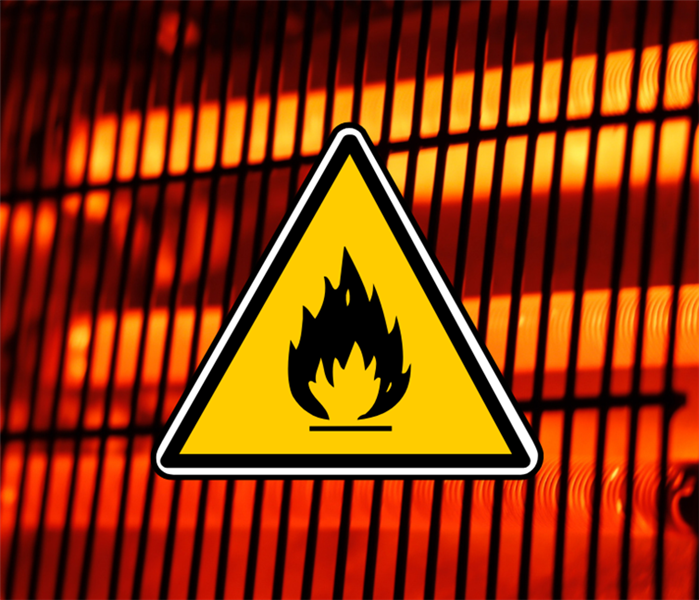 Anything that can burn should be kept at least three feet away from heating equipment!!
Anything that can burn should be kept at least three feet away from heating equipment!!
Keeping ourselves and our houses warm during winter can rapidly turn into a fire hazard, whether it's with a space heater, candles, or an electric blanket. There are various things you can do to make your home more fire-safe, as well as activities you can personally adopt to assist you to stay safe this winter.
Candles
- Candles should be kept at least 3 feet away from anything that can catch fire.
- Place candles in robust holders and in places where they won't be easily knocked over.
- Make sure that candles are out of reach of youngsters and dogs.
- If you leave the room, fall asleep, or go to bed, extinguish all candles.
Electrical equipment/appliances
- Only use one wall outlet at a time to plug in a heat-producing gadget (coffee maker, space heater, microwave, etc.).
- When using a heat-producing appliance, never utilize an extension cord.
- Extension cords should only be used for a short period of time.
- Furniture, beds, curtains, clothing, and flammable or combustible gases and liquids should all be kept away from lamps, light fixtures, and light bulbs.
Heaters
- Make room for space heaters! Anything that can burn should be kept at least three feet away from heating equipment (furnace, fireplace, wood stove, portable heater, etc.).
- When you leave the room or go to bed, turn off the space heater.
- A competent specialist should clean and inspect your heating equipment and chimneys once a year.
- Never heat your home using an oven.
Always make sure you have a working smoke and carbon monoxide alarm at all times in case of a fire.
10 Fire Safety Tips for Holiday Decorating
12/1/2021 (Permalink)
 10 Fire Safety Tips for Holiday Decorating
10 Fire Safety Tips for Holiday Decorating
Seasonal decorations, such as lights, trees, and wreaths, can help you get into the holiday spirit in your home. However, if decorations (particularly lights) are not used appropriately, they can pose a safety risk or cause fires.
Make sure your family is safe over the holidays. Read the manufacturer's instructions for each item before using it to learn how to use it properly. To guarantee that your holiday lights and decorations are placed correctly, follow these best practices:
- Check lights for frayed wires or cracks, and make sure each socket has a bulb. Discard and replace any strands that are damaged.
- Keep ladders and decorations away from electrical lines when decorating outside. Before climbing, make sure the ladder is securely in place on the ground.
- Underwriters Laboratory approval is required for lights. The letters "UL" will be prominently displayed on the tag, indicating that the product has been thoroughly inspected for possible safety dangers. The lights with red UL marks are safe for both indoor and outdoor usage, whereas the lights with green UL marks are exclusively safe for indoor use.
- When hanging lights, avoid hammering tacks or nails into the electrical cord. Instead, secure lights to the house with clips.
- Use heavy-duty extension cables, and only use cords outside if they are labeled as such. Use no more than three sets of standard lights per extension cord to avoid overloading them.
- Ground fault circuit interrupters (GFCI) should be used to connect outdoor lights and inflatable decorations to circuits. When the currents of the hot and neutral wires differ, GFCIs help prevent electric shock by breaking the circuit.
- Before going to bed or if you'll be gone from home, set a timer or turn out the lights.
- Use no more than two special ornaments per string that plug into a bulb receptacle, or see the manufacturer's instructions.
- Indoor lights should not be allowed to come into contact with draperies, furniture, or carpets. Also, keep lit candles away from flammable materials.
- Place cords and decorations in low-traffic locations where they won't be stepped on to avoid tripping. Cords should not be yanked, pinched, or crushed.
You will avoid risks and focus on friends and family during the holidays by taking basic precautions both inside and outside your house. Don't forget to check your lights and decorations throughout the season to make sure they're still working properly.
Happy Holidays, Stay Safe!
Safety Tips for Deep Frying a Thanksgiving Turkey
11/3/2021 (Permalink)
 Safety tips to protect yourself, your loved ones, and your home.
Safety tips to protect yourself, your loved ones, and your home.
It’s November, so it’s time for turkey!!!
Deep frying is the newest trend in Thanksgiving turkey preparation. The outcomes can be wonderful, but the process can be risky. I will explain why deep-frying is dangerous and share safety tips to protect yourself, your loved ones, and your home.
Why deep fryers can be dangerous
- The fryer has the potential to tip over and spill gallons of heated oil.
- When the turkey is placed into the cooking pot, overfilling the pot with oil produces leakage. If the oil spills onto the burner, the entire fryer will burst into flames.
- When frozen or partially frozen turkeys are placed in the fryer, steam quickly expands, causing the oil to boil over.
- If there are no thermostat controls, the fryer units have the potential to overheat to the point of combustion.
- The sides of the cooking pot, the lid, and the pot handles can become extremely hot, resulting in severe burns.
Deep-Fried Turkey Safety Tips
- Place the turkey fryer at least 10 feet away from your home and away from children and pets. It should never be left unattended.
- Place the fryer on a leveled, flat surface and carefully measure out the amount of oil required.
- Make sure your turkey is totally thawed and dry before cooking.
- Keep an eye on the temperature of the oil and use the fryer with caution. Severe burns from the lid and handle are possible.
- Always keep a fire extinguisher or multipurpose dry powder on hand in case oil catches fire.
Thanksgiving Safety Tips and Fire Facts
11/2/2021 (Permalink)
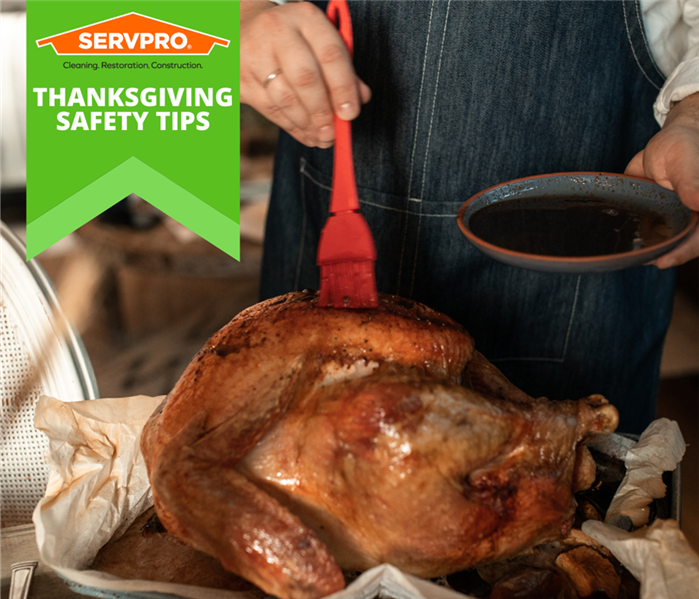 Thanksgiving Safety Tips and Fire Facts
Thanksgiving Safety Tips and Fire Facts
The kitchen is the heart of the home for most people, especially around the holidays. Everyone appreciates being a part of the preparations, from testing family recipes to creating cakes and pastries.
When there's a lot of activity and people at home, it's crucial to keep fire safety top of mind in the kitchen during this festive but chaotic time. As you begin to plan your holiday schedule and prepare a large family meal, keep in mind that by following a few easy safety tips, you can spend time with your loved ones while also keeping yourself and your family safe from fire.
Safety Tips
- While you're cooking, stay in the kitchen to keep an eye on the food.
- The stove will be very hot, so children should keep at least three feet away.
- Keep children away from hot foods and beverages. Vegetables, gravy, or coffee steam or splashes can cause significant burns.
- Make sure that no electric wires from a coffee maker, plate warmer, or mixer are dangling off the counter or within easy reach of a child.
- Matches and utility lighters should be kept out of reach of children, preferably in a locked cabinet.
- Never leave a lit candle alone in a room unattended.
- Check to see if your smoke detectors are working. By using the test button, you can put them to the test.
Thanksgiving Fire Facts
- Thanksgiving Day, the day before Thanksgiving, Easter, and Christmas Eve are the most common days for home cooking fires.
- On Thanksgiving Day in 2018, U.S. fire agencies responded to an estimated 1,630 home cooking fires, the busiest day for such disasters.
- Cooking that was left unattended was by far the most common cause of cooking fires and fire deaths.
How to keep your employees safe in the event of a fire!
9/28/2021 (Permalink)
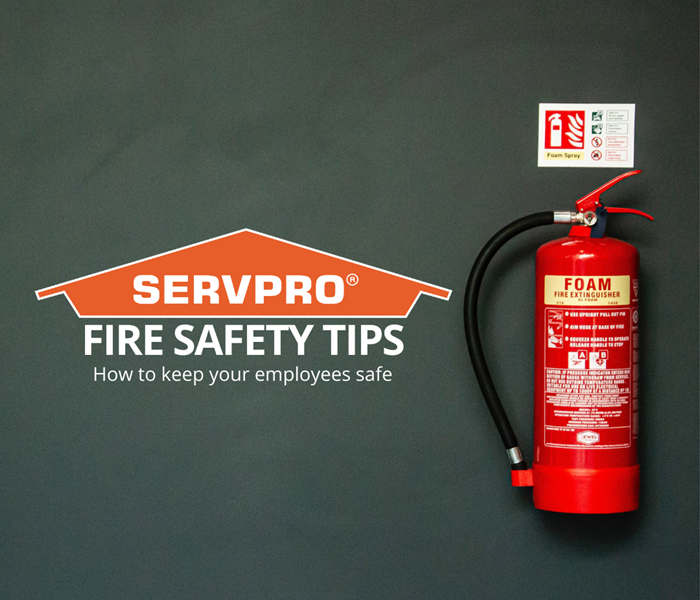 A portable fire extinguisher can save lives and property by putting out a small fire or containing it until help arrives.
A portable fire extinguisher can save lives and property by putting out a small fire or containing it until help arrives.
Your employees are not just members of your team, but also important assets to your company! These suggestions can help them avoid injury in the event of a fire:
- Conduct a fire drill at least once a year to ensure that your personnel are familiar with your workplace's fire safety procedures.
- Have a safety officer on the job. Assign someone to be the office's fire prevention officer. Composing escape routes and meeting points for employees, as well as keeping all of your safety plans, equipment, and information up to current, will be among their responsibilities.
- Sprinklers should be installed. Sprinkler systems are the most cost-efficient and effective technique to stop a fire from spreading. According to the National Fire Protection Association, fires were restricted to the room of origin 97 percent of the time when sprinklers were present.
- Make sure there's room for appliances. Allow some space behind heat-generating gadgets, such as coffee machines and computers, to allow them to cool down. Keep all of your office equipment away from flammable items such as paper or cloth. Unplug these appliances at the end of the day if at all possible, as most company fires occur after normal operation hours.
- Replace wires on a regular basis. Check power cords for fraying, broken connectors, and cracked insulation on a regular basis. These must be replaced right away. When using power strips, only use one extension cord per outlet and follow the manufacturer's specifications for maximum wattage. Avoid "octopus wiring," which occurs when multiple wires and plugs are tangled around a single outlet, as this might result in an overload.
- Plan for an evacuation. Post a fire evacuation plan in various locations throughout the workplace in larger buildings. Never use elevators as part of an evacuation strategy; instead, take the steps. In the event of an emergency, businesses with disabled employees should prepare a detailed evacuation plan for those employees who require additional support.
- Supply a first-aid kit. Employees should be familiar with the location of the first-aid kit in case of fire accidents, which should be located where fire dangers can occur most frequently, such as in the kitchen.
Smoking in the home
3/12/2021 (Permalink)
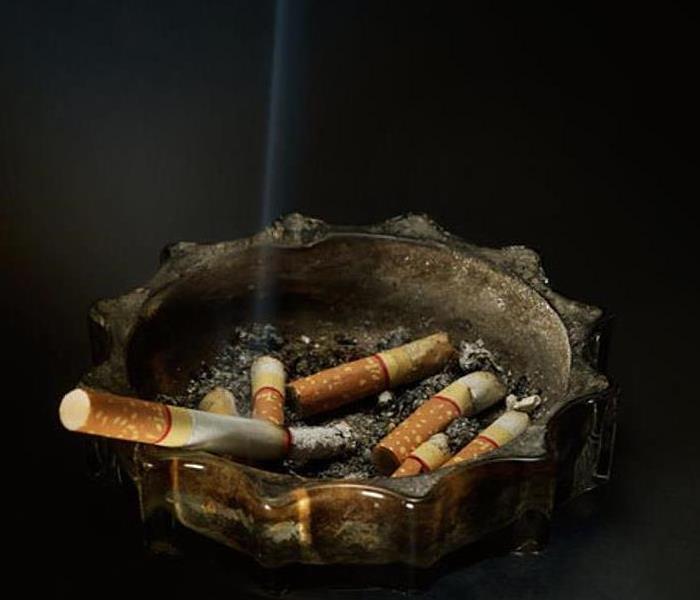 Emergency Response Service 24/7
Emergency Response Service 24/7
According to the National Fire Protection Association, smoking materials that include cigarettes, pipes, and cigars started an estimated 17,200 home structure fires. This was reported from U.S. fire departments. Amongst these 17,200 estimated fires, these fires cause 570 deaths, 1,140 injuries and $426 million in direct property damage. It was also reported that smoking materials caused 5% of reported home fires, 21% of home fire deaths, 10% of home fire injuries, and 6% of the direct property damage. According to the NFPA, most deaths in home smoking-material fires were caused by fires that started in bedrooms or in living rooms, family rooms or dens. It is also a face that the risk of dying in a home structure fire caused by smoking materials rises with age.
With that being said, it is encouraged to use smoking materials outside of the home. Designate a "smoking area" such as the garage or outside. This will help eliminate the risk of a fire starting in the actual home.
Lending a helping hand
1/5/2021 (Permalink)
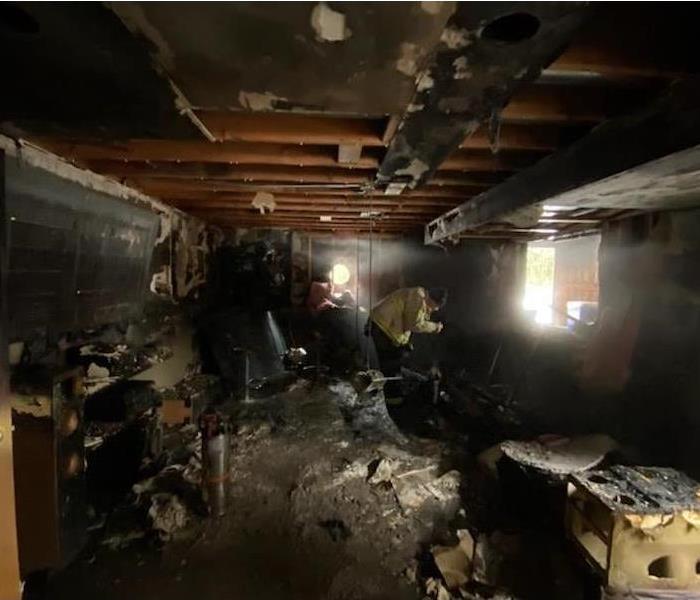 Residential Fire Damage
Residential Fire Damage
We have a really great relationship with our local fire departments, and follow their social media pages. After scrolling through our daily feed, we came across the Addison Fire Department's post about a local fire. What stood out about this post was that our local fire department and other FDs went to help with this major residential fire that took place. The AFPD responded to a house fire, and the smoke detectors did their job by alerting the family of the fire. They were all able to escape safely. They were very thankful for the help from the Wood Dale FPD, Elmhurst FD, and Itasca FPD for coming out to help. The family had told the firefighters that there were two guinea pigs in the home, and they where able to find and save them. They guinea pigs received O2 therapy and vigorous rubbing, and both were successfully resuscitated. The fire started in the basement, and the heat and smoke rose up throughout the house. They enforced to make sure your smoke detectors are working, and the batteries are changed! They also stated to make sure you keep your bedroom doors closed when sleeping, and try not to risk your life to save a pet. That is what the firefighters are for, and they will do their best to rescue them.
The main take away from this message was to always make sure to test your smoke detectors at least once a month, and the batteries should be replaced at least once or twice a year. Also, a huge shoutout to our local fire department for helping out a different fire department in order to get everyone out safely, along with the pets.
Life with a smoke detector – noisy peace.
12/1/2020 (Permalink)
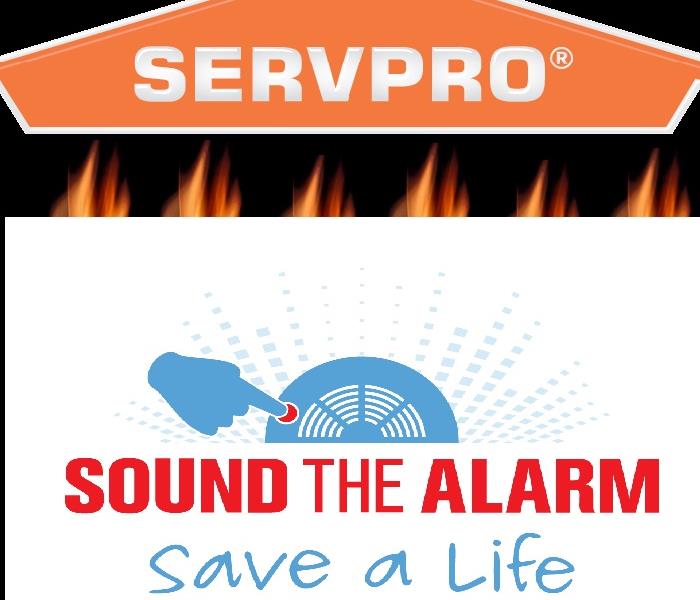 Follow the program
Follow the program
Almost 3,000 people every year die for a structure fire in the United States of America, that is 8 on average each day. That is like removing a ball team each day, everyday of the year. Not good, but with a few tips, maintenance and smoke detectors installed the number can be cut in half.
Smoke alarms should be tested once a month by pressing the TEST button. Smoke alarm batteries should be replaced in accordance with the manufacturer’s instructions, at least once a year. If an alarm “chirps” or “beeps” to indicate low batteries, they should be replaced immediately. Occasionally dust or lightly vacuum the exterior of the alarm to remove dust and cobwebs. Smoke alarms should be replaced in accordance with the manufacturer’s instructions, at least every ten years. Never paint over a smoke alarm.
After fire cleanup
11/3/2020 (Permalink)
Smoke and soot is very invasive and can penetrate various cavities within your home, causing hidden damage and odor. Our smoke damage expertise and experience allows us to inspect and accurately assess the extent of the damage to develop a comprehensive plan of action.
Smoke and soot facts:
- Hot smoke migrates to cooler areas and upper levels of a structure.
- Smoke flows around plumbing systems, seeping through the holes used by pipes to go from floor to floor.
- The type of smoke may greatly affect the restoration process.
Different Types of Smoke
There are two different types of smoke–wet and dry. As a result, there are different types of soot residue after a fire. Before restoration begins, SERVPRO of LaGrange Park/North Riverside will test the soot to determine which type of smoke damage occurred. The cleaning procedures will then be based on the information identified during pretesting. Here is some additional information:
Wet Smoke – Plastic and Rubber
- Low heat, smoldering, pungent odor, sticky, smeary. Smoke webs are more difficult to clean.
Dry Smoke – Paper and Wood
- Fast burning, high temperatures, heat rises therefore smoke rises.
Protein Fire Residue – Produced by evaporation of material rather than from a fire
- Virtually invisible, discolors paints and varnishes, extreme pungent odor.
Our Fire Damage Restoration Services
Since each smoke and fire damage situation is a little different, each one requires a unique solution tailored for the specific conditions. We have the equipment, expertise, and experience to restore your fire and smoke damage. We will also treat your family with empathy and respect and your property with care.
Have Questions about Fire, Smoke, or Soot Damage?
Call Us Today – 630-758-1701
Safety tips for the upcoming holidays
11/2/2020 (Permalink)
Per the National Fire Protection Association, nearly 47,000 fires occur during the winter holidays claiming more than 500 lives, causing more than 2,200 injuries, and costing $554 million in property damage. The National Fire Protection Association also states that on average, one of every 22 home fires started by Christmas trees result in death.
The website www.redcross.org/homefires, has several good home safety tips for the holidays to keep your home safe. We at SERVPRO LaGrange Park/North Riverside wanted to share some of those tips with you to ensure a safe holiday season.
- Place Christmas trees, candles, and other holiday decorations at least three feet away from heat sources like fireplaces, portable heaters, radiators, heat vents and candles.
- Purchase flame retardant metallic or artificial trees. If you purchase a real tree, make sure that it has fresh, green needles that aren’t easily broken. Keep live trees as moist as possible by giving them plenty of water.
- Make sure that light strings and other holiday decorations are in good condition. Do not use anything with frayed electrical cords and always follow the manufacturer’s instructions.
- Always unplug tree and holiday lights before leaving home or going to bed.
- Never use lit candles to decorate a tree. Always extinguish candles before leaving the room orgoing to bed.
- Use only sturdy tree stands designed not to tip over. Keep curious pets and children away from Christmas trees.
- Keep anything that can catch on fire—pot holders, oven mitts, wooden utensils, paper or plastic bags, food packaging, and towels or curtains—away from your stove top.
- Designate one person to walk around your home to make sure that all candles and smoking materials are properly extinguished after guests leave.
The following video also shares other great ideas to keep in mind this holiday season.
Holiday Fire Safety
Have a safe and wonderful holiday season from your friends at SERVPRO Elmhurst.
How can lint cause a dryer fire?
9/29/2020 (Permalink)
 Make sure to check your lint vent!
Make sure to check your lint vent!
Very few people realize the danger of clothes dryer fires. However, according to the U.S. Consumer Product Safety Commission, there are an estimated annual 15,500 fires, 10 deaths and 10 injuries due to clothes dryer fires. Several hundred people a year are also subjected to carbon monoxide poisoning from improper dryer vent setups. The financial costs come to nearly $100,000,000 per year. In some cases faulty appliances are to blame, but many fires can be prevented with proper dryer venting.
Lint accumulation and reduced airflow feed on each other to provide conditions ripe for a fire. Lint is a highly combustible material, which, interestingly enough, is one of the ingredients in a recipe for home-made fire starters. A number of dryer vent problems contribute to this. Most clothes dryers were in the basement. However, nowadays many newer homes tend to have dryers located away from an outside wall in bedrooms, bathrooms, kitchens and hall closets. These new locations mean dryers tend to be vented longer distances and vents are generally installed with sharp turns and bends to accommodate the structure of the home. As a result, dryer vents are harder to reach, and also create more places for lint to gather. The ideal solution is to have short, straight, dryer duct venting. However, a dryer vent booster, while not the ideal approach, can improve your dryer venting in cases where your venting is longer and/or has more bends than it should. In addition to creating a fire hazard, if the venting is too long and/or has to many bends, it will cause your dryer to take much longer than necessary to dry loads.
4 Important Steps for Fire Restoration
2/25/2020 (Permalink)
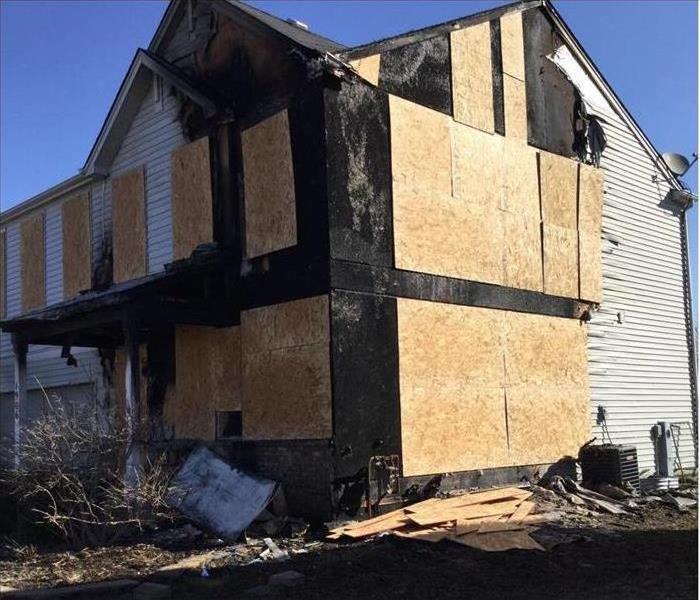 Board up services in a Berkeley, IL home
Board up services in a Berkeley, IL home
4 Important Steps for Fire Restoration
Home fires start for a number of reasons: an open flame that gets knocked over, an electrical malfunction, a forgotten stove burner or an escaped cinder from a fireplace. If you experience a home fire in Berkeley, IL, at some point the fire restoration process will begin. When you work with a professional fire remediation team you get a number of benefits such as a faster recovery process and reduced expenses. Here are some important things to keep foremost in mind.
1. Choose a Local Company. A fast response is important, and a local company can be on the scene in a matter of hours. Faster to Any Size Disaster means such things as smoke damage will be addressed quickly. An inspection and damage assessment will let you know the extent of the damage to your home.
2. Determine if Board-up and Tarp Services Are Needed. If the fire is a major one, your home will need to be secured from vandals and inclement weather. Cracked windows, broken doors and an open roof will need to covered up to prevent additional losses to property.
3. Remove Smoke and Soot Damage. Professional fire restoration technicians have the training and equipment to eradicate smoke odors and soot buildup in your home. Fire and water damage specialists will restore what items they can and replace what is necessary.
4. Continue With Cleaning and Repair. A thorough cleaning with the most effective cleaning agents continues the process. Certified damage cleaning techniques ensure your home is restored to its original condition. This will be done with as little disruption to your daily activities as possible.
The fire restoration process is designed to make your home livable again as quickly as possible. The goal is to make your home look "Like it Never Even Happened." A home fire is a challenging event to bounce back from, but it is achievable with help from experienced professionals.
Understanding Fire Restoration
11/22/2019 (Permalink)
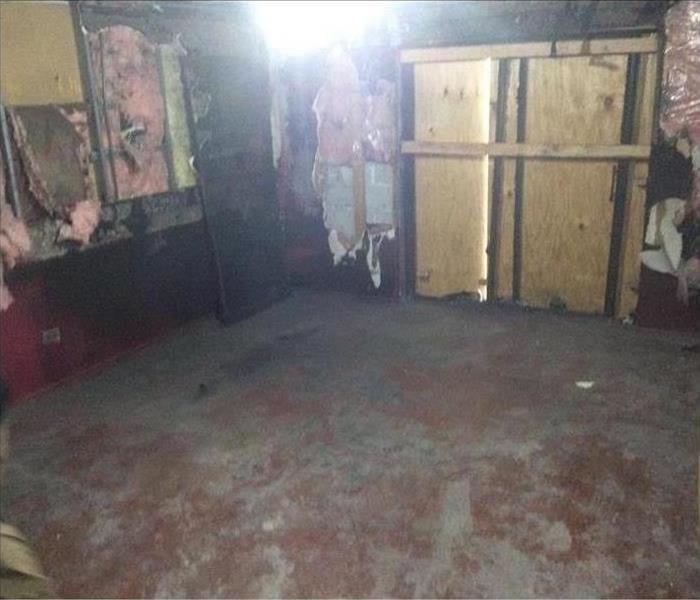 Fire restoration in a Berkeley, IL home
Fire restoration in a Berkeley, IL home
Understanding Fire Restoration
After a fire in your home, you have likely become familiar with the number of fire restoration companies and services in your area. However, you might be wondering what they do. The process of restoring your home is an involved one that likely requires five steps.
- Water removal
- Debris removal
- Smoke and soot cleaning
- Cleaning and sanitizing
- Restoration and rebuilding
Water Removal
Before any remediation or restoration service can begin damage cleaning, they must remove the excess buildup of water. While it might sound unusual when discussing fire damage, you must consider the efforts of emergency services in putting out the blaze. Fire hoses and suppression systems can leave an abundance of water, which can result in significant water damage if not dealt with immediately.
Debris Removal
After removing the water, a remediation team will begin the process of discarding the more significant elements of debris, such as furniture. You can accompany these teams into the property to sort through your belongings, as well.
Smoke and Soot Cleaning
Smoke damage is a challenging thing to alleviate. It is resilient and spreads through porous items and ventilation systems. Therefore, a restoration company will spend a significant amount of time cleaning any residue and odor from your home.
Cleaning and Sanitizing
A large portion of fire restoration services involves cleaning and sanitizing the property, even after the smoke and soot residue are gone. Therefore, before any rebuilding takes place, a company will spend a great deal of time with commercial cleaners and specialized HEPA-filtered vacuums.
Restoration and Rebuilding
Once the cleaning is completed by a fire restoration and remediation company in Berkeley, IL, they will begin the restoration and rebuilding phase. This is when the damaged property begins to look like your home again.
Fire restoration is a challenging and possibly a lengthy process, depending on the damage. However, when it is all said and done, you will have a home to return.
Choosing the Appropriate Fire Extinguisher
11/18/2019 (Permalink)
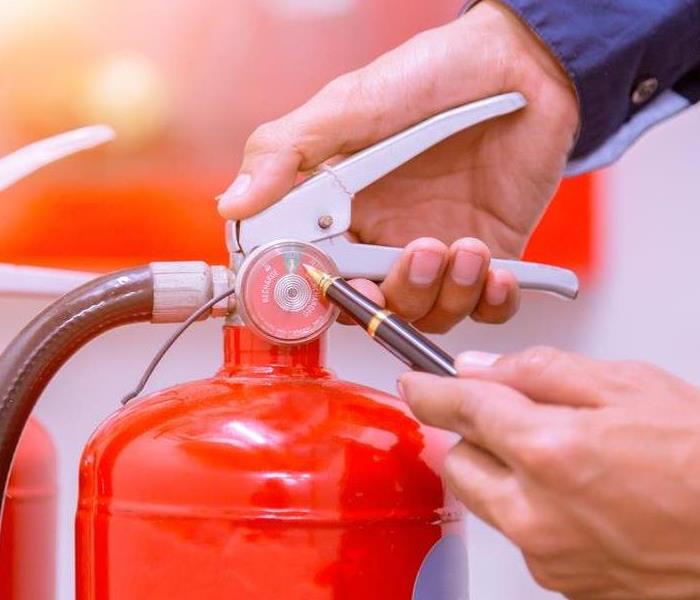 You need the very best help on the line as well.
You need the very best help on the line as well.
Choosing the Appropriate Fire Extinguisher
- Class A: This is the most common extinguisher and can be used to put out fires in ordinary combustibles such as cloth, wood, rubber, paper, and many plastics.
- Class B: Used on fires involving flammable liquids, such as grease, gasoline, and oil.
- Class C: Designed for fires involving appliances, tools, or other equipment electronically energized or plugged in.
- Class D: For use on flammable metals; often specific for the type of metal in question. These are typically found in factories.
- Class K: Intended for use on fires that involve vegetable oils, animal oils, or fats in cooking appliances. Generally found in commercial kitchens.
When fire or water damage puts the things that matter most on the line, you need the very best help on the line as well. That’s why knowing the easiest ways to contact SERVPRO is so important.
Just go to https://www.SERVPROelmhurst.com/to get the team that’s faster to any size disaster. We’re a leader in giving control back to homeowners, property managers, and even entire communities after the ravaging effects of water or fire. So, whether you’re responsible for 1,000 square feet or 100,000 –be ready for the worst with the very best: Your trusted, SERVPRO of Elmhurst team.
Basic Information About Renters Insurance and Fires
10/9/2019 (Permalink)
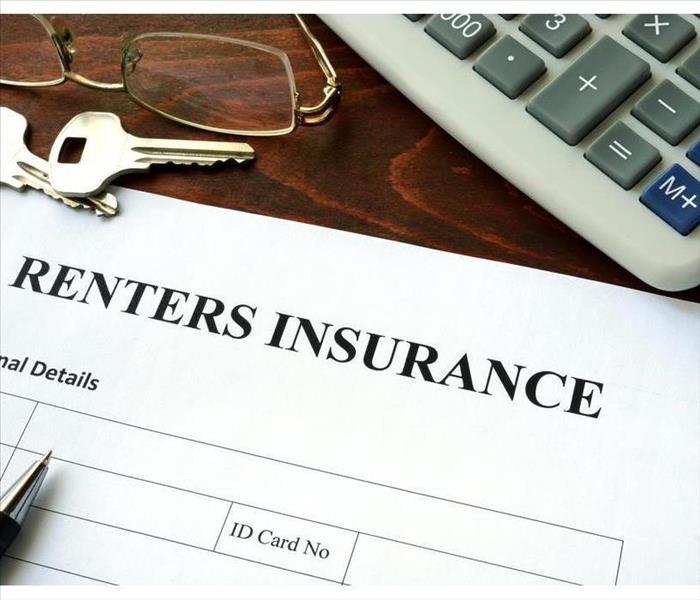 Renters insurance covers a variety of expenses after a fire so be sure to check your policy
Renters insurance covers a variety of expenses after a fire so be sure to check your policy
Basic Information About Renters Insurance and Fires
If you’ve ever experienced the devastating effects of a home fire, you’re likely aware of what your insurance covers. If you’ve never had to deal with fire damage, you’re probably not sure what’s included. Here is some basic information about the three types of coverage and how they relate to your renters insurance after a fire.
Personal Property
Under personal property coverage, fire is considered a covered peril. A peril is any type of unexpected event that results in your personal belongings being damaged or ruined. One thing you can do if you experience a home fire is call a fire restoration specialist to assist in fire damage cleanup. These professionals are Faster to any size disaster and can help clean and remove the prevalent smoke smell from your home. Once you’ve had your home cleaned, you’ll be able to determine what items need to be replaced under your personal property coverage.
Liability
Liability is another type of coverage under your renters insurance. This coverage applies when a fire causes injuries or damage to someone and their belongings due to the fire in your home. As with all types of coverage, limits apply so be sure to understand the specifics of your policy.
Additional Living Expenses
If you’re not able to live in your Elmhurst, IL, apartment or home due to fire damage, your insurance should cover additional living expenses. Fire restoration is essential after a fire and it may take some time until you’re able to return back home. This coverage could cover hotel and food expenditures above what you would normally spend.
Renters insurance covers a variety of expenses after a fire so be sure to check your policy. Personal property, liability and additional living expenses are three types of coverage you should include in your policy. Fire restoration is an important part of getting your home back to normal so contact a professional for assistance.
EVERY SECOND COUNTS
10/5/2019 (Permalink)
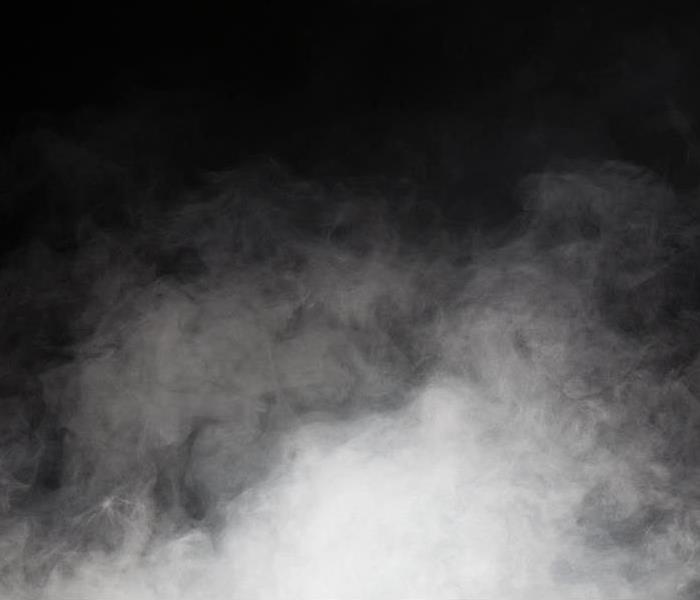 Practice your fire escape plan during the day and at nighttime.
Practice your fire escape plan during the day and at nighttime.
Every second counts during a fire. Fire experts agree; people have as little as two minutes to escape a burning home before it’s too late major fire, making it critical to be prepared and have an escape plan in place. A survey conducted by the American Red Cross shows only 26 percent of families and businesses have developed and practiced a fire escape plan. Once a plan is developed, it is critical everyone in the home or office understands the plan. The best way to do this is by practicing the escape plan at least twice a year. Increase your chance of surviving a fire by ensuring you have working smoke detectors in place, building an escape plan, and then practicing it. The following are a few suggestions to help you develop an emergency escape plan.
Draw a map of each level of your home or business and show all the doors and windows. Find two ways to get out of each room. Make sure all doors and windows that lead outside open easily.
Consider escape ladders for sleeping areas on the second and third floors. Only purchase collapsible escape ladders evaluated by a recognized testing laboratory. Store them near the window where they will be used.
Choose an outside meeting place a safe distance in front of your home where everyone can meet after they’ve escaped. Make sure to mark the location of the meeting area on your escape plan.
Teach children how to escape on their own in case you cannot help them. Plan for everyone in your home or office, with special considerations for elderly or disabled individuals. Practice your fire escape plan during the day and at nighttime.
PLAN and PRACTICE your ESCAPE!
9/30/2019 (Permalink)
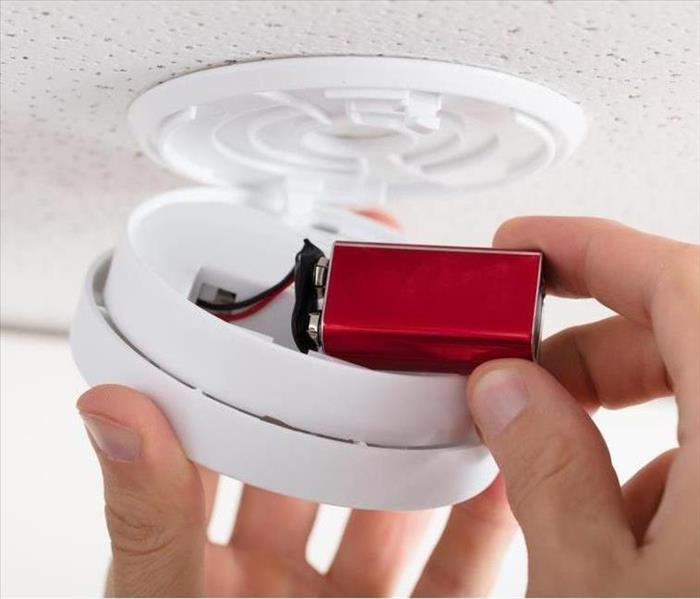 October is Fire Prevention Month and an excellent time to examine the emergency preparedness plans for your home and business.
October is Fire Prevention Month and an excellent time to examine the emergency preparedness plans for your home and business.
October is Fire Prevention Month and an excellent time to examine the emergency preparedness plans for your home and business, including your fire escape plan. Do you have a fire escape plan? Have you changed your smoke alarm batteries within the last year? Are you prepared if a disaster strikes?
The National Fire Protection Association (NFPA) sets aside a designated week each October to focus on fire prevention. The 2019 theme is "Not Every Hero Wears a Cape. Plan and Practice Your Escape!"
According to the NFPA, once the fire alarm goes off, "you could have less than one to two minutes to escape safely," yet only 8 percent of people surveyed said getting out was their first thought after hearing a fire alarm. Creating, implementing, and practicing a fire escape plan for your home or business may be the difference between safety and tragedy. Make a plan today! Escape planning and practice can help you make the most of the time you have, giving everyone in your home or business enough time to get out.
How do you define a hero? Is it a person who is courageous and performs good deeds? Someone who comes to the aid of others, even at their own personal risk? A hero can be all of those things! A hero can also be someone who takes small but important actions to keep themselves and those around them safe from fire. When it comes to fire safety, be a hero in your household or community.
In this issue of the September Restoration Newsline, we will cover several fire safety topics, as well as information on creating your fire escape plan.
SERVPRO of Elmhurst wants you to stay safe, informed, and prepared to help ensure you are ready for any disaster that comes your way.
Lightning-Caused House Fires are Seriously Dangerous
7/31/2019 (Permalink)
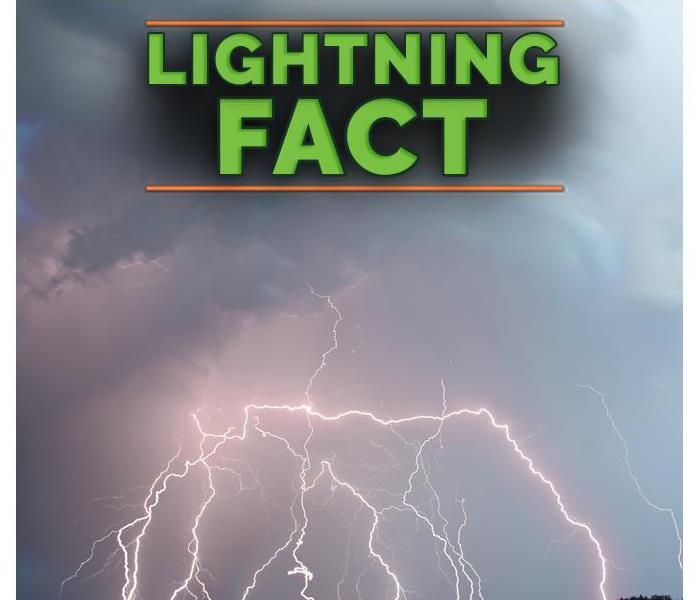 One strike in Besenville, IL can easily cause a lightning fire
One strike in Besenville, IL can easily cause a lightning fire
Lightning is an incredibly common event. Every second, there are around 45 flashes of lightning globally, and the power of just one strike in Bensenville, IL, can easily cause a lightning fire. The U.S. averages about 51 deaths and nearly 23,000 fires caused by lightning strikes per year. While only about 18% of fires caused by strikes occurred in homes, they caused the majority of deaths, injuries and overall losses.
Lightning Fire in Houses
Studies show that while less than 1/5th of lightning fires occurred in homes, they accounted for
- 88% of civilian deaths associated with lightning caused fires,
- 77% of the associated injuries, and
- 70% of the direct property damage
Lightning-caused house fires are responsible for around nine deaths, 53 injuries and over $450 million in property damage each year on average. The ubiquity and power of this natural force is often overlooked – until something dreadful happens.
Another problem caused is damage to electronics. Some power companies offer a lightning-protection device that they install in your service box. While not perfect, this has been shown to mitigate a great deal of damage to devices and in some cases may be guaranteed to cover losses.
What to Do If Your Home Is Struck by Lightning
Lightning can be insidious – if you know your home has been struck, call the fire department. As electricity, it always takes the path of least resistance, meaning the damage can be hidden. Attic fires have been known to develop and smolder for quite some time before showing symptoms of fire damage. Its path can branch out and go totally unexpected routes, so it’s best to be safe. The fire department can come out and inspect your home for hidden dangers.
Dealing With the Aftermath of a Lightning Fire
With luck and a proactive approach, you can keep the damage very limited. However, once a fire has caused significant smoke damage, you should contact your insurance agency in Bensenville, IL, to file a claim. The residue from a fire is often toxic and difficult to locate and remove so insurance will normally pay for a professional fire damage cleanup.
Your Home Needs THIS Many Fire Alarms and Other Facts That May Surprise You
7/17/2019 (Permalink)
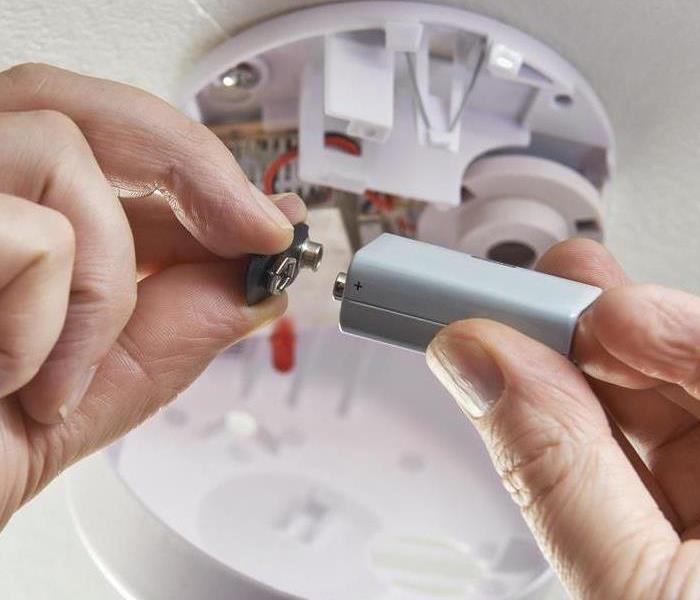
If you're like the average American, your home has one fire alarm, two tops, and that's not enough. According to one survey, Americans need to equip their homes with another 100 million smoke alarms to be fully protected.
It's not enough to have working alarms, though. You also need to know how to react when an alarm goes off. Test your fire safety knowledge by attempting to answer the questions below.
Q: How Many Fire Alarms Should the Average Home Have?
A: The National Fire Protection Association recommends placing one alarm in every bedroom, one outside each sleeping area and one on every level of the home. So, if your home has three bedrooms and two stories, you need a minimum of five fire alarms.
Q: What Type of Fire Alarm Should You Install in Your Home?
A: An ionization alarm sounds when a fast-moving fire occurs while a photoelectric alarm detects smoke damage and smoldering fires. Because you cannot anticipate what type of fire will move through your home, you need both types of detectors.
Q: How Often Should You Replace Your Fire Detector?
A: Everyone knows to replace their batteries after one year or when they start chirping, but how often should you replace the fire detector itself? Do you need to do it annually, every five to seven years or every eight to 10 years? The answer is every eight to 10 years.
Q: How Many Minutes Do You Have to Escape a House Fire?
A: Had you asked a fire damage professional 10 or 20 years ago, he or she might have said you have between 20 and 30 minutes to get out. The reality is you have between three and four minutes to get out of a house that's on fire. This short timeframe is why it is so important to have smoke detectors throughout your home.
This information is not meant to alarm you but simply to inform you. If you only have one fire alarm, go out and buy four more. For more safety tips, talk to your Elmhurst, IL fire department.
3 Tips To Eliminate Cigarette Smoke Odor
7/10/2019 (Permalink)
Cigarette odors can be very persistent. It is possible to eliminate the smell that lingers after smoking indoors through home deodorization treatments. Here are three tips that can be helpful for getting rid of the residual smell of cigarette smoke at a home in Elmhurst, IL.
1. Clean Exposed Surfaces
Nicotine, tar, and other chemicals in cigarettes can cause a residue to form on surfaces such as ceilings, walls, and window blinds. These surfaces can be treated with either dry or wet cleaning methods.
A chemical sponge is an effective way to clean residues. This treatment does not contain chemicals and is made of absorbent rubber. Wet cleaning with a degreasing cleaner such as Trisodium Phosphate or the phosphate-free TSP-PF formula can break up residue and eliminate odors. These treatments are ideal before allowing painted surfaces to dry, applying a stain-blocking primer, and repainting.
2. Filter the Air
Air filtration can reduce the number of smoke particles in the air. Homeowners may use a free-standing HEPA air filter or attach an air scrubber to an HVAC system. Filtration may not completely eliminate smoke odors. A home deodorization treatment can reach smoke particles on surfaces or areas that are difficult to clean and neutralize smells.
3. Deodorize
There are several treatments that a homeowner can pursue depending on the severity of smoke odors. Ozone machines and thermal foggers are both very fast and effective, but require evacuation during treatment. Hydroxyl generators and vapor modification may take longer, but these treatments can proceed while occupants remain at home.
These three tips can help a homeowner get rid of the odor of cigarette smoke at a residence in Elmhurst, IL. While it may be possible to start the cleanup process on your own, a smoke damage remediation service can provide home deodorization treatments to ensure that every trace of the smell is gone.
3 Things You Should Know About Emergency Board Up Services
7/5/2019 (Permalink)
After a fire, your Elmhurst, IL home may have quite a bit of damage. Depending on the severity of the fire, it can affect the structure of your home. If this is the case, it might be necessary to board up your home. Here are a few things that might help you to better understand the process.
1. What Is Emergency Board Up?
This service is fairly self-explanatory. If there has been a lot of damage to your home, there can be missing walls or roofing that leave the inside of your home exposed. These services will cover these areas to reduce exposure.
2. Why Should You Do This?
There are several reasons that it is a good idea to board up your home after a fire. Perhaps the most important is that leaving the interior of your home exposed can result in further damage. If there is a storm, your home is vulnerable to wind or rain damage. It can also keep people and animals out as well. In some cases, your insurance company will require this kind of mitigation and failing to do so can prevent the damage from being covered by your policy.
3. How Is It Done?
If you need to board up your home, you should consider hiring an emergency restoration service to do it for you. They will have the tools and experience to make sure everything is done correctly and with quality materials. They will likely use a light material such as plywood for highly damaged areas as well as broken doors and windows. Tarps can be used to cover the roof.
Fire damage can be extensive and require a lot of rebuilding and restoration, so using an emergency board up service can be helpful. It can prevent further damage which will make the process of repairing your home go more quickly. Using a professional company will ensure that the job is done well.
Fire Damage Restoraton Information
9/5/2017 (Permalink)
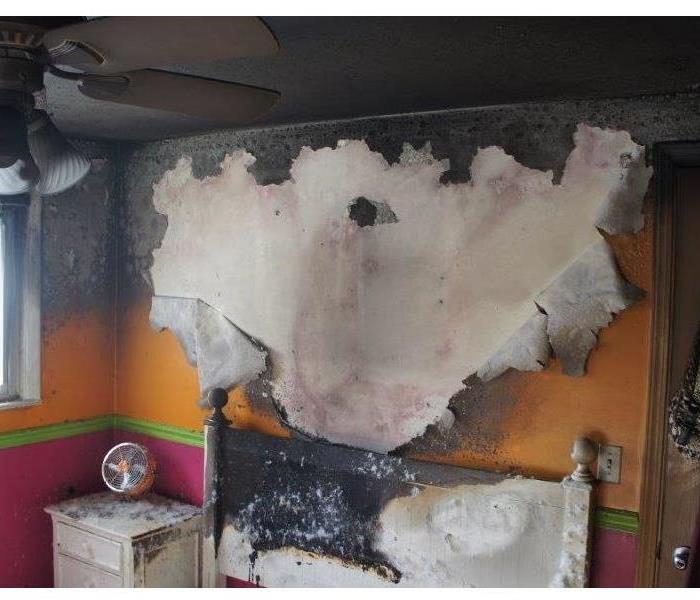 Fire in bedroom
Fire in bedroom
There is nothing more devastating than a fire in home or fire in business. Seeing one's personal belongings or business products go up in smoke is a stunning experience that makes one wonder what to do next. Often the first indication of a fire is the smoke smell.
The day following a fire is the time to start planning on fire damage restoration. Fortunately, there are commercial fire damage companies who specialize in the fire cleanup process. In a severe fire, one is talking about fire cleanup starting from scratch. However, in many cases the fire is confined to a limited area.
The first step is to contact a commercial fire damage company that specializes in fire cleanup. This company will have the equipment and expertise to clean up smoke damage, soot damage, a smoke smell and all the other problems that have been caused by the fire.
1. Upon being contacted, the professionals will immediately arrive on the scene to make an inspection and determine the amount of the damage. Whether it is a fire in home or a fire in business, they will carefully survey the area and provide a written estimate of the cost of the repairs. This is especially important with commercial fire damage where there are often large amounts of salable goods involved.
2. If the fire damage has caused a breech in the walls, roof or windows, the professionals will immediately use boards and tarps to cover these areas to prevent further damage. This protects the property from vandals or weather damage.
3. Unfortunately, fire hoses must spray water to put out a fire. This is part of the fire damage that is left behind. Removing this water quickly will avoid things like warped boards or the formation of mold. Professionals are equipped with large dehumidifiers, blowers and air movers to clear the area of excess water and dry the area.
4. Today's professionals in the business have the equipment and materials to return many of the items suffering from soot damage or smoke damage to their pre-fire condition. They sanitize and clean all items that are salvageable.
5. Smoke damage and soot damage are fire damage restoration problems that require special consideration. Using special equipment, as much smoke and soot as possible will be removed. In many cases it will be necessary to repaint or refinish some surfaces that are smoke stains. This, as well as replacing drywall, making minor or major reconstruction, painting and so forth, can be done by the specialists by contract.
Commercial fire damage can be costly. Not only in the actual damage to a building and goods, but in the lack of business caused by the shutdown. This makes it imperative to obtain the services of a specialist in the area of fire damage restoration. An experienced company will be able to quickly access the damage and present a plan to cover all aspects of cleaning up the fire in business circumstances.
When a fire in home is involved, have a professional immediately address problems such as soot damage, smoke damage, smoke smell and general all over fire cleanup. They will carefully explain the cost, the methods used and the end result. As a rule, an insurance company must be contacted before work can begin.
Professionals in the area of fire damage restoration are especially trained in the ins and outs of fire damage that occurs when there is a fire in home or a fire in business. In addition to training, they have the equipment and materials to address things such as smoke damage, soot damage, smoke smell and other things caused by fire damage. This makes it possible for them to start work immediately after a fire and have the home or business back in tip-top shape quickly and efficiently. Visit http://www.SERVPROElmhurst.com for more information on fire damage.





 24/7 Emergency Service
24/7 Emergency Service
